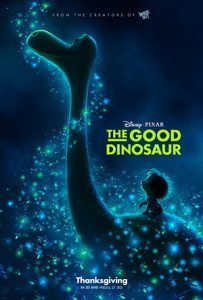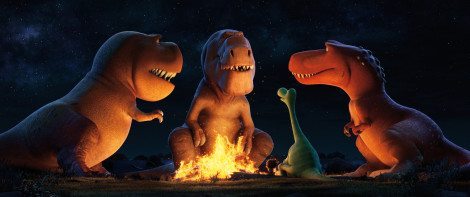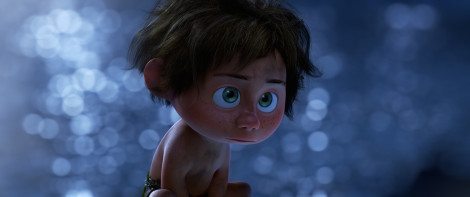The Good Dinosaur (2015)
 Release Date: November 25, 2015
Release Date: November 25, 2015
Cast: Raymond Ochoa, Jack Bright, Sam Elliott, Anna Paquin, A. J. Buckley, Jeffrey Wright, Frances McDormand
Director: Peter Sohn
Studio: Walt Disney Pictures, Pixar Animation Studios
Distributor: Walt Disney Studios Motion Pictures
Genre(s): Children’s, Adventure, Comedy
Rating: ★★★☆☆
Review Spoilers: Medium
IMDB | Rotten Tomatoes | Wikipedia
At some point we’ll have to give up on the “Pixar Standard.” Yes, for a solid fifteen years, the company made not only the best children’s movies in the business, but some of the best movies, period. They took the genre to heights we never could have guessed, arguably surpassing even the golden age of Disney, and those who grew up alongside it watched in awe as, while our former enjoyment of the likes of Madagascar and Ice Age diminished and eventually disappeared, our love for Pixar only grew richer.
Times have changed. Cars 2 happened. The release schedule, once populated with exciting new concepts, began to fill with sequels. And just as we started to mourn, Inside Out turned out to be one of the best movies of the year and yet another encapsulation of the intelligence, originality and heart we’ve always loved in the studio’s work. Alas, there was hope.
But only briefly, because The Good Dinosaur may not be their worst movie yet, but it’s certainly their least mature. Like Brave but doubly so, it caters more directly to the child audience than any of their other films, taking on the cliches and tropes that so often plague their competitors. And there’s nothing inherently wrong with first-time director Peter Sohn making a children’s movie, you know, for kids, especially given criticisms against Inside Out‘s perhaps too-complex story, but the result feels like a generic oversimplification of what could have been something really special.

When Arlo sees Spot around the farm again and chases him down, they both tumble into the river and get swept up in the current. They wake up together miles from home, and though Arlo blames Spot for his father’s death, they have no choice but to join forces if they have any chance of getting home.
Conceptually, the film is fascinating right from the initial concept. The film boldly characterizes the dinosaurs as the intelligent dominant species and, creationists be damned, humans as the evolutionary equivalent of dogs. And much of the fun of the movie comes from seeing the various other fictional animals that have evolved without the asteroid stunting them, from snakes with arms to three foot long bugs. It’s all clever stuff, and generally done subtly with relatively little attention drawn to it.

Same goes for the plot, which does rather little to cover up its strict coherence to the Hero’s Journey structure. Even the father’s death at the beginning feels like it happens mostly out of obligation and routine. And the final climactic confrontation comes out of nowhere, as a group of somewhat villainous characters from early in the film follow the protagonists all the way to their destination for… what reason exactly? Well, because Arlo needs an obligatory scene to prove his newfound bravery, of course.
The whole affair does have a lot of heart, though, and the kids will probably love it. On that note, though, there are a handful of bizarrely adult moments worth noting if you intend to take a young child to this. One dinosaur rescues a small, adorable fox-like creature from under a collapsed tree, then swallows it whole on-camera. At another point, Arlo and Spot accidentally eat some rotten peaches and sink into a crazy acid-like hallucinogenic trip. Why Sohn decided to insert such dark points into otherwise most kid-friendly film is beyond me.
![[Disney]](http://www.nerdophiles.com/wp-content/uploads/2015/11/GD-landscape-470x197.jpeg)
Final Thoughts: Some creative concepts and beautiful visuals can’t cover up The Good Dinosaur‘s generic story and lack of character depth.